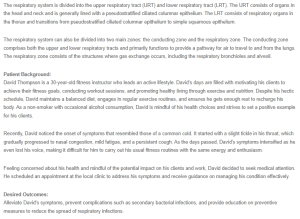Anatomy and Functions of the Human Respiratory Tract
The Upper and Lower Respiratory Tracts
The upper respiratory tract is made up of the nose, nasal passage, larynx, pharynx, and sinuses. Conversely, the lower respiratory tract is made up of the bronchi, trachea, bronchioles, lungs, and the alveoli within the lungs.
The Mucociliary Escalator
The mucociliary escalator is the defense system of the respiratory tract against pathogens and foreign particles. The airways are lined by ciliated epithelial cells, and goblet cells produce mucus. The mucus produced traps pathogens and foreign particles. The cilia move in a coordinated wave-like manner (Lee et al., 2023). The motion of the cilia moves the mucus with trapped particles upwards towards the throat. In the throat, the mucus can be swallowed or expelled. This is how the mucociliary escalator keeps the respiratory system safe from pathogens and foreign particles.
Anatomical Structures Involved in Phonation and Voice Production
The larynx is the organ that produces the voice. Across the larynx are two bands of muscle and connective tissue called the vocal cords. When the vocal cords are closed or partly closed, the air is blown out of the lungs, and through them, they vibrate and make a sound. The muscles of the larynx change pitch by varying the length and tension of the vocal cords (Sataloff, 2021). The oral and nasal cavities that alter the sound to make different voices and speech, as well as the throat, which is a resonating chamber, are other anatomical structures involved in voice production. Articulating and shaping the sounds into speech also involves the lips, tongue, and soft palate.
Regions of the Pharynx
The pharyngeal divisions are the nasopharynx, oropharynx, and laryngopharynx (McCullagh et al., 2022). The highest is the nasopharynx, above the soft palate and behind the nasal cavity. It is a tube-like structure with adenoid tonsils on its posterior wall. Below the nasopharynx is the oropharynx. The lateral walls have the palatine tonsils. The base of the tongue has the lingual tonsils. The laryngopharynx extends from the hyoid bone to the esophagus and larynx. It is a passageway for food and air, sending them into the larynx and esophagus.
Nasal Conchae’s Function in the Nasal Cavity
To warm and humidify inspired air.
References
Lee, R. E., Reidel, B., Nelson, M. R., Macdonald, J. K., Kesimer, M., & Randell, S. H. (2023). Air-Liquid interface cultures to model drug delivery through the mucociliary epithelial barrier. Advanced Drug Delivery Reviews, 198, 114866. https://doi.org/10.1016/j.addr.2023.114866
McCullagh, K. L., Shah, R. N., & Huang, B. Y. (2022). Anatomy of the larynx and cervical trachea. Neuroimaging Clinics, 32(4), 809–829. https://doi.org/10.1016/j.nic.2022.07.011
Sataloff, R. T. (2021). Anatomy and Physiology of the Voice. In Dentofacial Anomalies: Implications for Voice and Wind Instrument Performance (pp. 3–13). Cham: Springer International Publishing. https://doi.org/10.1007/978-3-030-69109-7_1
ORDER A PLAGIARISM-FREE PAPER HERE
We’ll write everything from scratch
Question
The respiratory system is divided into the upper respiratory tract (URT) and lower respiratory tract (LRT). The URT consists of organs in the head and neck and is generally lined with a pseudostratified ciliated columnar epithelium. The LRT consists of respiratory organs in the thorax and transitions from pseudostratified ciliated columnar epithelium to simple squamous epithelium.

Anatomy and Functions of the Human Respiratory Tract
The respiratory system can also be divided into two main zones: the conducting zone and the respiratory zone. The conducting zone comprises both the upper and lower respiratory tracts and primarily functions to provide a pathway for air to travel to and from the lungs. The respiratory zone consists of the structures where gas exchange occurs, including the respiratory bronchioles and alveoli.
Patient Background:
David Thompson is a 30-year-old fitness instructor who leads an active lifestyle. David’s days are filled with motivating his clients to achieve their fitness goals, conducting workout sessions, and promoting healthy living through exercise and nutrition. Despite his hectic schedule, David maintains a balanced diet, engages in regular exercise routines, and ensures he gets enough rest to recharge his body. As a non-smoker with occasional alcohol consumption, David is mindful of his health choices and strives to set a positive example for his clients.
Recently, David noticed the onset of symptoms that resembled those of a common cold. It started with a slight tickle in his throat, which gradually progressed to nasal congestion, mild fatigue, and a persistent cough. As the days passed, David’s symptoms intensified as he even lost his voice, making it difficult for him to carry out his usual fitness routines with the same energy and enthusiasm.
Feeling concerned about his health and mindful of the potential impact on his clients and work, David decided to seek medical attention. He scheduled an appointment at the local clinic to address his symptoms and receive guidance on managing his condition effectively.
Desired Outcomes:
Alleviate David’s symptoms, prevent complications such as secondary bacterial infections, and provide education on preventive measures to reduce the spread of respiratory infections.
Findings:
David underwent a thorough examination by the healthcare provider. The assessment revealed clear nasal discharge, mild pharyngeal erythema (redness), and tender cervical lymph nodes. Despite his symptoms, David’s vital signs remain stable, with no evidence of fever or respiratory distress. Lung auscultation confirms clear breath sounds bilaterally, without any wheezes or crackles. David’s overall clinical presentation suggests a viral upper respiratory tract infection, likely exacerbated by close contact with an affected individual at the gym.
Questions:
- Identify the structures of the upper and lower respiratory tracts.
- How does the mucociliary escalator function to remove foreign particles and pathogens from the respiratory tract?
- Describe the anatomical structures involved in phonation and voice production.
- Identify the different regions of the pharynx and their anatomical features (location, shape, tonsils, etc.).
- What is the function of the nasal conchae in the nasal cavity?
- To warm and humidify inspired air
- To produce tears for lubricating the nasal passages
- To detect olfactory stimuli
- To aid in vocalization during speech production

